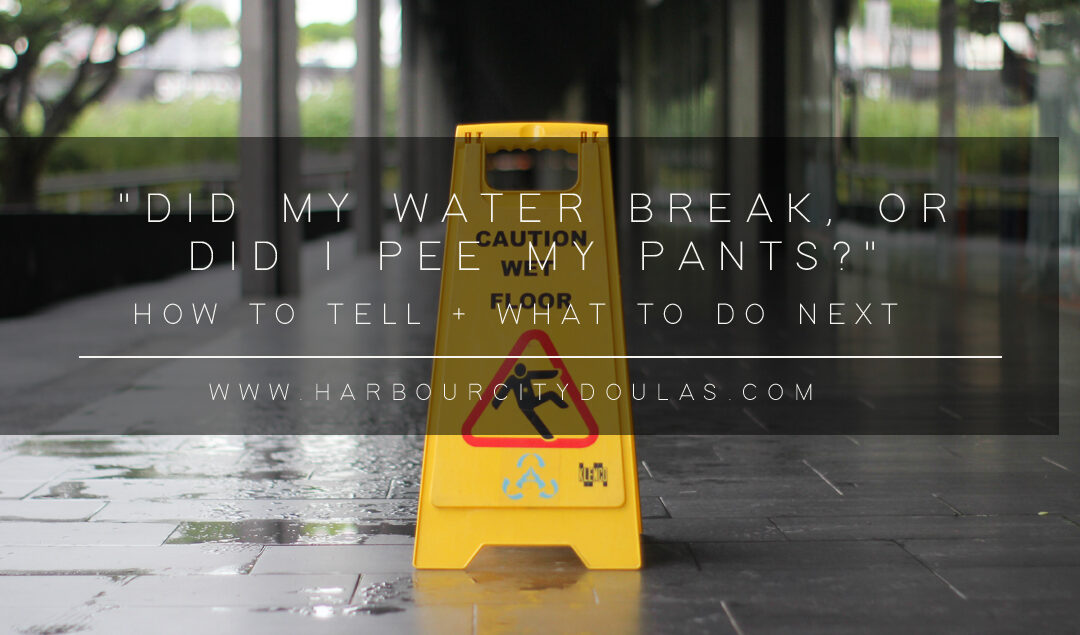By the time you’re nearing your due date, there can be a lot going on down there. Even if this isn’t your first pregnancy, sometimes it can be difficult to tell if your water just broke, especially if it was broken for you during your last labour. Even though most labours don’t begin this way (the most common time for your water to break is when you’re 9 centimeters dilated!), it’s important to be able to tell the difference between amniotic fluid and other normal late-pregnancy symptoms. We’ve all heard the stories about someone’s water breaking in the middle of Walmart, and likely about that friend that was sent home from the hospital because even though they were sure their water had broken, it was really just pee.
So, how can you tell? First, let’s talk about what else you might be experiencing in your underwear. At the end of your pregnancy, your body is working incredibly hard to put the finishing touches on a new human while simultaneously preparing your body to give birth to said human. This means you may experience:
- increased vaginal discharge- this could be anything from thin and clear to thick and creamy. If it is an unusual color or smells foul, be sure to let your doctor or midwife know.
- increased sweating- remember, you’re working hard! Especially in the warmer months, you may find yourself sweating everywhere. Wear loose fitting cotton undies, stay cool and hydrated, and enjoy some nice long baths!
- urine incontinence. We know this is the least appealing option on the list- and we’re sorry. But, it’s really normal at the end of pregnancy (your baby is putting a lot of pressure on your bladder!), and it usually gets better after birth.
If you’re pretty sure that what you’re dealing with isn’t on the above list, it’s time to move on to figuring out if it’s amniotic fluid.
Test One: Color
Usually, amniotic fluid is clear, though sometimes it’s normal if there’s some blood in there, too. Sometimes, it will appear brown or green-tinged if baby has had a bowel movement inside (known as meconium). Whatever color it is, take note of it, because your care provider will ask!
Test Two: Smell
It’s not for everyone, but if you can’t tell based on the color, you may consider smelling the fluid. If it smells like ammonia or urine, it likely is. If it smells sweet or like bleach, it may be amniotic fluid. Again, if it smells foul, get in touch with your provider.
Test Three: Take a break
Try laying down on your side for 10-15 minutes (we promise, even if your water DID break, you’ve got time to do this). Use this time to rest, calm your nerves, and practice deep breathing exercises. When the time is up, slowly get up and take note of any new fluid. If there’s another gush, it’s possible your water has broken, as it will continue to leak out whenever you change positions.
Test Four: What else do you feel?
If the mystery fluid was discharge, sweat, or pee, you probably won’t feel anything unusual. If you feel cramps, a backache, nausea, loose bowels, or contractions, then it’s possible your water has broken!
When in doubt, call your midwife or head in to the hospital.
If you can’t figure out what the fluid might be, if you’re feeling uneasy about it, or if your baby isn’t moving as much as usual, it’s best to page your midwife or just head to the Perinatal Unit at the hospital where they can perform a simple test to determine what the fluid is. A litmus test is a simple test that involves putting a sample of the fluid on a strip of special test paper. The paper will change color if it was amniotic fluid. Arts and crafts in labour and delivery!
The other test is called a “ferning test”. A sample of fluid is placed on a microscope slide and allowed to air dry. Your midwife or nurse will look at the slide under the microscope, and if the fluid has dried in the shape of fern plants- it’s baby time!
Remember, most labours don’t start this way- you’re much more likely to experience the typical slow build-up of contractions with increasing intensity. Even if you are one of the estimated 7% of people who experience a rupture of membranes before their first contraction, don’t let Hollywood fool you. You’re very unlikely to ruin anyone’s shoes or flood the grocery store in the way the movies like to portray, and you don’t need to drop everything and rush to the hospital.
What DOES it feel like when your water breaks?
- You may feel a gentle “pop”. It may feel like how you’d imagine it would feel if a balloon burst inside of you.
- You may feel a small gush of fluid- very rarely is it enough water to leave a puddle!
- You may have just a trickle of fluid- especially possible if your baby’s head is very low and creates a “seal” on your cervix, blocking the rest of the water behind him
One thing is for certain: your water breaking means that it’s almost time to meet your baby! Take a deep breath, drink some water, and call your doula. You’ve got this!

Recent Comments